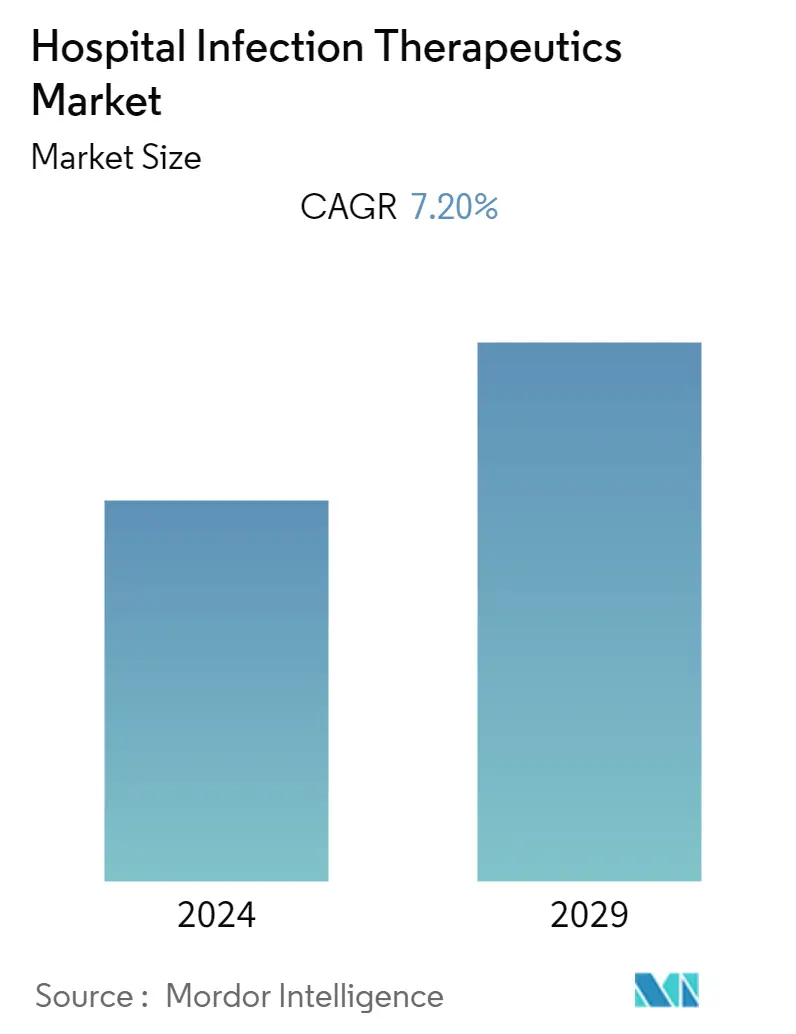Market Size of Hospital Infection Therapeutics Industry

| Study Period | 2019 - 2029 |
| Base Year For Estimation | 2023 |
| Forecast Data Period | 2024 - 2029 |
| CAGR | 7.20 % |
| Fastest Growing Market | Asia Pacific |
| Largest Market | North America |
Major Players
*Disclaimer: Major Players sorted in no particular order |
Need a report that reflects how COVID-19 has impacted this market and its growth?
Hospital Infection Therapeutics Market Analysis
The hospital infection therapeutics market is expected to register a CAGR of 7.2% over the forecast period.
The COVID-19 pandemic had an impact on the hospital infection therapeutics market initially. With the outbreak of COVID-19, the hospital infection therapeutics market experienced a moderate hike in growth. It was primarily due to the massive influx of COVID-19 patients, which also led to the spread of the infection within the hospitals and other healthcare facilities. For instance, a multicentre study published in the Journal of Critical Care in January 2021 mentioned that COVID-19 patients were found to have a high risk of contracting ventilator-associated pneumonia from the invasive ventilation at the intensive care unit of the hospital. However, from late 2021, the number of COVID-19 cases decreased, which led to a gradual decrease in the burden of HAIs (healthcare-associated infections), and so did the demand for hospital infective therapeutics. However, cases of HAIs are still present due to the increasing number of surgeries and other factors that would keep the demand for the hospital infective therapeutics in the post-pandemic. Thus, the COVID-19 outbreak significantly impacted the market's growth in its preliminary phase. Moreover, the market is expected to grow further at a stable pace with the increasing cases of HAIs.
Further, the market is expected to grow with the high prevalence of HAIs and the high volume of surgeries that are associated with infections. The numbers of HAIs are high, which is expected to create more demand for hospital infection therapeutics. For instance, as per the data published by the United States Department of Health & Human Services in November 2022, over 373,602 cases of surgical site infections were reported by acute care hospitals in the United States in 2021. The same source stated that over 3,709 cases of methicillin-resistant Staphylococcus aureus (MRSA) were reported by acute care hospitals in the United States in 2021.
Furthermore, a high volume of surgeries would increase the risk of HAIs and surgical site infections, which would create more demand for hospital infection therapeutics. For instance, a study published in the Journal of Plastic, Reconstructive & Aesthetic Surgery in June 2021 highlighted the risk of HAIs associated with breast removal surgeries as the patient stays in the hospital. The study stated that the long stay at the hospital after the mastectomy and increased length of surgical drain retention are likely to cause infections in older female patients. The increasing number of such procedures is propelling the growth of the market. For instance, according to the OECD (Organization for Economic Co-operation and Development), in 2023, over 50,597 and 3,619 procedures of complete mastectomies were performed in Turkey and Portugal, respectively, in 2021.
Additionally, a study published in the Journal PLoS in June 2021 highlighted that in the studied population, the prevalence of post-cesarean section (CS) surgical site infection in hospitals (SSI) was 12.3%. Such an increased risk of infection after a cesarean procedure contributes to the growth of the market. Also, the Organization for Economic Cooperation and Development (OECD) in 2023 stated that over 82,532 and 21,268 cesarean sections were performed in Chile and Ireland, respectively, in 2021. Thus, the high volume of surgical procedures and the high risk of postoperative infections are expected to create more demand for hospital infection therapeutics to curb surgical site infections.
Also, the key developments by the market players in the hospital infection therapeutics market are expected to boost the growth of the market. For instance, in March 2022, Cumberland Pharmaceuticals Inc. and Tabuk Pharmaceutical Manufacturing Company, a fully owned subsidiary of Astra Industrial Group, signed a partnership to launch Cumberland's Vibativ (telavancin) injection in the Middle East. The drug is intended to curb hospital-acquired and ventilator-associated pneumonia caused by the wide array of gram-positive bacterial pathogens and multi-drug-resistant microbes. Also, in November 2022, Eugia, the subsidiary of Aurobindo Pharma, received FDA approval for Amphotericin B Liposome for Injection. The generic drug is used for the treatment of fungal infections.
Therefore, owing to the aforementioned factors, including the increasing prevalence of HAIs and increasing volume of surgeries, the studied market is anticipated to witness growth over the analysis period. However, the increasing antimicrobial resistance is likely to impede the market growth.
